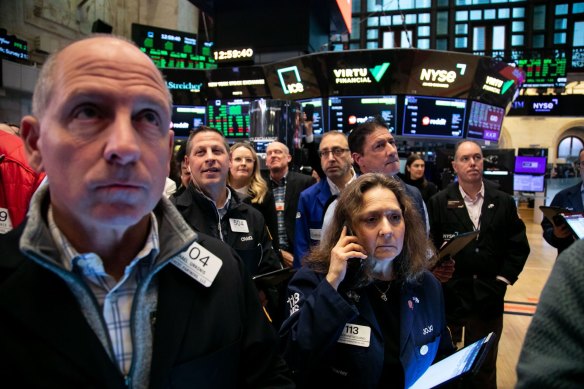Opinion
The market carnage is over for now, but volatility is the new black
Elizabeth Knight
Business columnistThe market caught its breath on Tuesday – but don’t get comfortable.
In market parlance, in the past couple of days, investors flipped the switch from “risk-on” to “risk-off”. Or in other (more vulgar, but elucidatory) words: the market crapped its pants.

Volatility in equities markets is something investors can bank on. Credit: Bloomberg
The ensuing meltdown all but wiped out the 6.4 per cent gain the S&P/ASX 200 had made since the start of 2024. And it only took two days to do it.
Tuesday’s reprieve kicked into gear just as suddenly and violently as the sell-off did on Friday. The VIX index, which measures volatility (often referred to as the fear index), almost broke the charts.
After a horror showing on US markets on Monday (early Tuesday morning AEST), Australian investors braced for yet another assault.
What happened next is testament to the fickleness of markets. US futures turned on a dime and began moving up, signalling that the two-day rout was over – at least for now. The Australian market responded by moving back into positive territory, settling down after its wild ride.
What’s interesting about the sharemarket flash mini-correction (which wasn’t a technical correction because it didn’t fall 10 per cent) is what sparked it.
The final straw, most agree, was Friday’s release of soft US labour market data, precipitating a somewhat frenzied fear that the world’s largest economy was heading for recession.
Curiously, softer economic data sets in the United States have until last week been positive for stocks because they were seen as enhancing the size and frequency of prospective rate cuts. Typically, rate cuts are positive for sharemarkets as they make it cheaper for companies and consumers to borrow money.
But this time, the weak labour data made punters panic that hopes for a soft landing had soured and that the world’s largest economy was recession-bound.
The strange part is that this view smacks of undue pessimism, and most well-credentialed economists don’t share it – nor do they think the labour market numbers were especially weak.
It felt like an excuse for investors to sell off the market because parts of it had become too frothy – the results of what, again, in stockmarket parlance is called a “crowded trade”.
Crowded trades are what we would call popular trades: stocks, or even indexes, that investors have been piling into, this year in particular. The demand pushes prices up to levels that are not supported by their fundamental valuation.
The top US technology stocks are a case in point. Their heavy weighting in the Nasdaq and the S&P 500 means that Wall Street becomes vulnerable to any sell-off in these stocks.
The largest of them all, the chipmaker Nvidia, so dominates the market that it can almost single-handedly set off a sharemarket tsunami.
In three trading days, Nvidia fell 24 per cent and took the septet of tech giants – Apple, Meta, Alphabet, Microsoft, Amazon and Tesla – on the wild slide.
Over the past eight months, the so-called “magnificent seven” have been the most crowded trade in the US market, in large part because of the enthusiasm around next-generation AI and its ability to supercharge their earnings.
There are now questions being asked about the timing of these future earnings explosions. Nvidia’s share price had already begun to wobble over the past six weeks as doubts were cast over whether its popularity was overdone.

The US has its “magnificent seven” of tech stocks, whereas Australia has the “fabulous four” of big banks.Credit: Dominic Lorrimer
For another example of crowded trades, closer to home, we need look no further than our “fabulous four” banks.
For months, the hard heads in the stockbroking community have warned that banks’ share prices – particularly for the daddy of them all, the Commonwealth Bank – have been rising well above justifiable levels.
Despite what is shaping up to be an underwhelming profit season for banks, investors have crowded into these shares all year, and seemingly few had been prepared to bet that they would come down.
This overcrowded trade was ripe to be hit hard by a market correction. And while the banks recovered nicely on Tuesday as the Australian sharemarket stabilised, they were slammed on Monday. And because these lenders and a few big miners dominate the S&P/ASX 200, the fall in bank shares produced a disproportionately negative impact on the broader market.
Between Thursday and Monday, the CBA’s share price fell more than 8 per cent, Westpac was off 7 per cent, NAB cratered 8.6 per cent and ANZ declined by 6 per cent.
A third example of crowded trades is Japan. Investors around the world had been borrowing Japanese yen because of that country’s low-interest rate, and investing in assets with higher yields.
Japan’s rate rise last week and investor attempts to unwind that “carry trade” in yen have been part of the domino effect that ruffled world markets.
Equity markets are increasingly dominated by passive index-tracking investors rather than stock pickers, which exacerbates herd investing and therefore crowded trades, and makes them more vulnerable to triggers than could come from anywhere.
Strangely enough, a US recession is the least likely trigger.
But strap in, with a US election in sight, the ride may stay bumpy for a while.
The Market Recap newsletter is a wrap of the day’s trading. Get it each weekday afternoon.